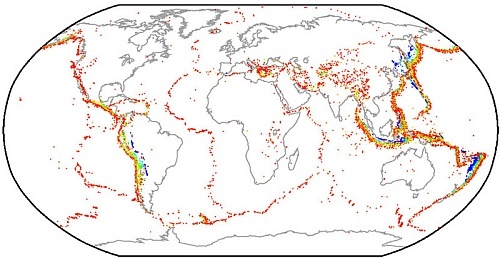Sumatra 2004. Wenchuan 2008. Haiti 2010. Japan 2011. In each case, the story was
the same: An earthquake struck without warning, taking thousands of
lives
and smashing buildings like sand castles.

Geoscientists still can't predict when a major quake will strike, and many have given up trying.
But many do try to issue more general forecasts of hazards
and potential damage. This week, researchers added a potentially
powerful new tool to their kit: the largest seismic database of its kind
ever constructed,
based on tens of thousands of earthquake records stretching back
more than 1000 years. Together with a new global map of strain
accumulation at plate
boundaries, the data sets will form the core of an international
public-private partnership intended to reshape the science of earthquake
forecasting.
The Global Earthquake Model (GEM) Foundation, which has been
developing the seismic risk platform since 2009, unveiled key components
of it at a meeting
here, called Reveal 2013.
"To advance the science of earthquake forecasting we must enhance
the data," GEM co-founder Ross Stein told the opening session. Stein, a
seismologist with
the U.S. Geological Survey, and a handful of other disaster experts
proposed the project in 2006, with the aim of bringing a systematic and
open approach
to a discipline that had previously been hampered by disparate
methods. "Everyone knew we needed to do this," Stein says. "No one was
willing to put the
money up. GEM did."
To develop the new maps, researchers refigured the magnitudes and
locations of nearly a thousand historic earthquakes dating back to 1000
C.E. according to
strict, uniform new criteria. Using modern algorithms, they also
recalculated seismogram records of 20,000 earthquakes over the past 100
years at a cost of
€1 million. To get a handle on the driving force behind most
earthquakes, other geoscientists reappraised the movements of Earth's
tectonic plates to
estimate the rate of deformation at plate boundaries. In all, they
deduced 20,000 velocities from measurements at 70,000 stations around
the world. GEM
says that the software used to analyze the data, known as OpenQuake,
will be publicly released next year to set a uniform and open standard
in hazard
calculations.
GEM hopes to develop better ways to calculate both seismic hazard—the probability that earthquakes will occur over the next 50 years—and
seismic risk, the casualties and economic losses likely to
result. Risk is of particular interest to the insurance companies that
fund much of
GEM's research. At the meeting, researchers unveiled an ambitious
new project to assess the quality of building stocks around the world,
using national
data sets, satellite imagery, and on-the-street censuses recorded by
smart phone apps.
Reveal 2013 participants say that they are impressed by the
partnership's rapid progress. "We do have our own world map of natural
hazards," says Anselm
Smolka of the insurance firm Munich Re, which has donated €5 million
to the program. "But with a team of just 20, we cannot do more. We need
cooperation.
GEM gives industry access to a global network of scientists."
Seth Stein, a geophysicist at Northwestern University in Evanston,
Illinois, and a longtime critic of quake forecasting, says that he
welcomes the attempt
to bring clarity to the field. But he warns that no amount of data
collection can overcome the deep uncertainties inherent in Earth
faulting processes. For
example, he says, even a complete 2000-year history of seismic
shaking in China would have given planners no clues to the three most
devastating events
that have struck since 1950. "GEM is doing a good job of improving
the things that can be improved," says Seth Stein (who is not related to
Ross Stein).
"So a better record will help us some. But whether it will ever be
adequate to allow us to fully characterize the probability of events, my
guess is
probably no."
Ross Stein acknowledges the need for humility in the face of Earth's
complexities: "We must tell the public what we know; and we must tell
them what we don't know—in language they understand."
Source.
Earthquake prediction in July of 2013
|
 Main
Main 
 Registration
Registration Login
Login